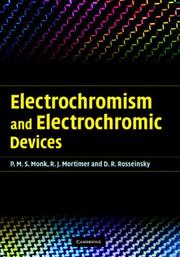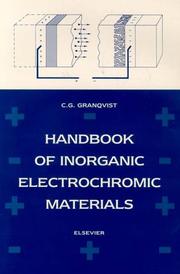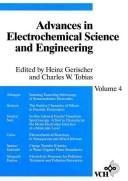| Listing 1 - 10 of 16 | << page >> |
Sort by
|

ISBN: 9780521822695 0521822696 9780511550959 Year: 2007 Publisher: Cambridge Cambridge University Press
Abstract | Keywords | Export | Availability | Bookmark
 Loading...
Loading...Choose an application
- Reference Manager
- EndNote
- RefWorks (Direct export to RefWorks)
Book
ISBN: 1107174511 9786612058196 0511507402 1282058193 0511500173 0511508069 0511503970 0511508727 0511550952 0511506112 Year: 2007 Publisher: Cambridge ; New York : Cambridge University Press,
Abstract | Keywords | Export | Availability | Bookmark
 Loading...
Loading...Choose an application
- Reference Manager
- EndNote
- RefWorks (Direct export to RefWorks)
Electrochromic materials, both organic and inorganic, have widespread applications in light-attenuation, displays and analysis. Written in an accessible manner, this book provides a comprehensive treatment of all types of electrochromic systems and their many applications. Coverage develops from electrochromic scope and history to new searching presentations of optical quantification and theoretical mechanistic models. Non-electrode electrochromism and photo-electrochromism are summarised, with updated comprehensive reviews of electrochromic oxides (tungsten-trioxide particularly), metal co-ordination complexes and metal-cyanometallates, viologens and other organics; and more recent exotics such as fullerenes, hydrides, and conjugated electroactive polymers are also covered. The book concludes by examining device construction and durability. With an extensive bibliography, recent advances in the field, modern applications and a step-by-step development from simple examples to sophisticated theories, this book is ideal for researchers in materials science, polymer science, electrical engineering, physics, chemistry, bioscience and (applied) optoelectronics.
Book
ISBN: 9783527336104 Year: 2015 Publisher: Weinheim, Germany : Wiley-VCH,
Abstract | Keywords | Export | Availability | Bookmark
 Loading...
Loading...Choose an application
- Reference Manager
- EndNote
- RefWorks (Direct export to RefWorks)
Book
ISBN: 9783862197774 3862197778 9783862197767 386219776X Year: 2014 Publisher: Kassel, Germany : kassel university press,
Abstract | Keywords | Export | Availability | Bookmark
 Loading...
Loading...Choose an application
- Reference Manager
- EndNote
- RefWorks (Direct export to RefWorks)
Electrochromic devices --- Vehicles. --- Transportation --- Devices, Electrochromic --- Electrochromic displays --- Electrooptical devices --- Materials.
Book
Year: 2009 Publisher: Golden, CO : National Renewable Energy Laboratory,
Abstract | Keywords | Export | Availability | Bookmark
 Loading...
Loading...Choose an application
- Reference Manager
- EndNote
- RefWorks (Direct export to RefWorks)
Windows --- Electrochromic devices --- Energy conservation. --- Testing.

ISBN: 1281985112 9786611985110 008053290X 0444899308 Year: 1995 Publisher: Amsterdam ; New York : Elsevier,
Abstract | Keywords | Export | Availability | Bookmark
 Loading...
Loading...Choose an application
- Reference Manager
- EndNote
- RefWorks (Direct export to RefWorks)
Electrochromic materials are able to change their optical properties in a persistent and reversible way under the action of a voltage pulse. This book explores electrochromism among the metal oxides, with detailed discussions of materials preparation (primarily by thin film technology), materials characterization by (electro)chemical and physical techniques, optical properties, electrochromic device design, and device performance. The vast quantity of information presented is structured in a systematic manner and the optical data is interpreted within a novel conceptual framework. The public
Electrochromic devices --- Metallic oxides --- Organic compounds --- Materials. --- Optical properties. --- Compounds, Organic --- Organic chemicals --- Carbon compounds --- Metal oxides --- Metals --- Oxides --- Devices, Electrochromic --- Electrochromic displays --- Electrooptical devices

ISBN: 352729063X 9783527290635 Year: 1995 Publisher: Weinheim VCH
Abstract | Keywords | Export | Availability | Bookmark
 Loading...
Loading...Choose an application
- Reference Manager
- EndNote
- RefWorks (Direct export to RefWorks)
Organic compounds --- Electrochromic devices --- Inorganic compounds --- Materials --- 544.164 --- -Inorganic compounds --- Compounds, Organic --- Organic chemicals --- Carbon compounds --- Compounds, Inorganic --- Inorganic chemicals --- Chemicals --- Chemistry, Inorganic --- Devices, Electrochromic --- Electrochromic displays --- Electrooptical devices --- Relation of chemical structure to optical properties --- Electrochromic devices - Materials
Book
ISBN: 0128242337 9780128242339 9780128239728 0128239727 Year: 2021 Publisher: Duxford, England : Woodhead Publishing,
Abstract | Keywords | Export | Availability | Bookmark
 Loading...
Loading...Choose an application
- Reference Manager
- EndNote
- RefWorks (Direct export to RefWorks)
"Functional Materials Processing for Switchable Device Modulation focuses on the advances of nanofabrication that underpin emerging technologies, including electronic devices. The book provides readers with a broad view of the materials’ perspectives, including historical context and background, along with future opportunities for smart electronic and switchable devices. A major focus in the book is on the research and development of synthetic materials for spectroscopic analysis which broadly deals with science and technology of materials on the atomic and molecular scale. The book reviews the materials and advances in research for switchable electronics for bioelectronic, sensing and optoelectronic applications."--
Electrochromic devices --- Nanostructured materials --- Materials. --- Optical properties. --- Devices, Electrochromic --- Electrochromic displays --- Electrooptical devices --- Nanomaterials --- Nanometer materials --- Nanophase materials --- Nanostructure controlled materials --- Nanostructure materials --- Ultra-fine microstructure materials --- Microstructure --- Nanotechnology --- Spectrum Analysis --- Biosensing Techniques --- instrumentation
Dissertation
Year: 2019 Publisher: Liège Université de Liège (ULiège)
Abstract | Keywords | Export | Availability | Bookmark
 Loading...
Loading...Choose an application
- Reference Manager
- EndNote
- RefWorks (Direct export to RefWorks)
In this work we studied the synthesis, dispersion and wet deposition of molybdenum-tungsten hybrid oxide as novel plasmonic electrochromic materials. We successfully synthesized these hybrid materials using a one step solvothermal route. The recovered powders were characterized in terms of their morphology, crystallinity, optic properties, and behavior under annealing conditions. Then, the powders were dispersed in usual low toxic solvents to be used as "electrochromic inks" for the ensuing deposition. The stability of the dispersions was evaluated both qualitativelly and quantitatively, with and without addition of stabilizing agents. The best results were obtained using either a dispersing agent (PEG 140k in ethanol and PEI in water) or in the case of heavily loaded suspensions (150 mg/mL), taking advantage of the interparticle steric hindrace. 10 mg/mL dispersions with PEG in ethanol and 150 mg/mL surfactant-free dispersion in ethanol were used as active "inks" for spin coating and bar casting respectively. We managed to produce active films using both techniques, however, the superior quality of the deposited film using bar casting led to improved electrochromic properties
Plasmonic --- Electrochromic --- Molybdenum-tungsten hybrid oxide --- LSPR --- smart windows --- Physique, chimie, mathématiques & sciences de la terre > Chimie
Dissertation
Year: 2020 Publisher: Liège Université de Liège (ULiège)
Abstract | Keywords | Export | Availability | Bookmark
 Loading...
Loading...Choose an application
- Reference Manager
- EndNote
- RefWorks (Direct export to RefWorks)
For the last decades, international organizations have attached a huge importance to building’s energy-efficiency. In fact, the construction sector is one of the most responsible for the greenhouse gas emissions and accounts for more than 40% of the total energy consumption. Furthermore, the occupant comfort became a decisive factor of the user’s satisfaction. In addition, the European Union intends to recognize the smartness of building with a Smart Readiness Indicator (SRI). In this way, emerging dynamic building envelopes that are adaptive façades are high potential solutions for the building sector. Moreover, these can significantly reduce the energy demand and improve occupant comfort. Many studies analyzed the impact of such façades by investigating one or several of these technologies. However, a single adaptive façade family was mostly studied. Thereby, in this thesis, four smart envelopes from four different families have been simulated and investigated through EnergyPlus with the help of DesignBuilder. Additionally, three control strategies were chosen to study the dynamic aspect of such systems. These are based on solar, operative temperaturel and glare control. The study aims to perform the energy, thermal and visual comforts performances. Then, the building envelope technologies are compared with a base case based on BESTEST case 600 which consist of a single office room with two windows. The simulated location is Uccle, in the Brussels-capital region in Belgium. Finally, a sensitivity analysis is made to strengthen the results and to determine influential parameters. By comparing the different dynamic building technologies, it is demonstrated that dynamic shading devices and electrochromic glazing have a remarkable influence on the energy savings with a decrease of the total annual loads that can reach 31,3% compared to a simple office room without smart technologies. They mostly influence the cooling energy loads. Double-skin façades have a smaller impact on the energy consumption. However, these can significantly improve thermal comfort by decreasing discomfort hours by 14,8% compared to the base case. In fact, electrochromic glazing and dynamic shading do not really influence thermal comfort. In addition, this study points out the importance of control strategy’s choice and parameters. Due to DesignBuilder limitations, visual comfort has only been investigated for double-skin façade cases. Nevertheless, this adaptive façade is able to reduce drastically unwanted daylight by more than 35%. In conclusion, this thesis helps to determine the impacts of transparent adaptive façades on energy and comfort performances in office buildings. By studying several adaptive façade families and control strategies and different impact criteria, an overview of their potential is possible and can help in decision making of such façades. Depuis quelques décennies, les organisations internationales accordent de plus en plus d’importance à l’efficacité énergétique des bâtiments. En réalité, le secteur de la construction est responsable de plus de 40% de la consommation d’énergie totale. En outre, le confort des occupants est un facteur primordial pour améliorer leur satisfaction. De plus, l’Union Européenne désire évaluer l’intelligence des bâtiments à l’aide d’un indicateur : le Smart Readiness Indicator (SRI). Ainsi, les nouvelles technologies dynamiques d’enveloppes, que sont les façades adaptatives, promettent d’offrir des solutions de qualité pour le secteur de la construction. Aussi, celles-ci peuvent considérablement diminuer la demande d’énergie et améliorer le confort des occupants. Plusieurs études portent sur l’analyse d’une ou plusieurs de ces technologies. Mais la plupart du temps, ces dernières font partie de la même famille de façade adaptive. C’est pourquoi, cette thèse de master simule et étudie quatre systèmes de quatre familles différentes de façades adaptatives à l’aide du logiciel EnergyPlus. D’autre part, trois stratégies de contrôle ont été choisies pour évaluer l’aspect dynamique de ce genre de système. Celles-ci sont basées sur le contrôle par les gains solaires, la température opérative et l’index d’éblouissement. L’étude porte sur l’évaluation des performances énergétiques et de conforts thermique et visuel. Outre cela, ces technologies sont comparées à un cas de base, fondé sur le cas 600 de BESTEST qui consiste en une simple pièce de bureau avec deux fenêtres. La localisation de la simulation est, quant à elle, fixée à Uccle, ville de la région de Bruxelles-capitale en Belgique. Finalement, une étude de sensibilité est effectuée afin de déterminer si des paramètres sont susceptibles de varier. En comparant ces différentes technologies d’enveloppes intelligentes, il est démontré que les pare-soleils dynamiques et le vitrage électrochromique permettent d’économiser remarquablement la consommation d’énergie jusqu’à 31,3% comparé au cas de base. Ceux-ci agissent principalement sur la demande de refroidissement. Les façades double-peau ont un impact plus modeste sur la demande d’énergie. Néanmoins, elles permettent d’améliorer le confort thermique en diminuant les heures d’inconfort thermique jusqu’à 14,8% par rapport au cas de base. En réalité, le vitrage électrochromique et le pare-soleil dynamique n’influencent que très peu le confort thermique. De plus, cette étude met en évidence l’importance du choix de la stratégie de contrôle et du paramétrage. Cependant, les limitations du logiciel utilisé ont réduit l’étude du confort visuel aux cas de façade double-peau. Toujours est-il que ce type de façade peut réduire le rayonnement solaire non-désiré de plus de 35%. En conclusion, cette thèse de master permet de déterminer les impacts des façades adaptatives transparentes sur les performances énergétiques et de confort dans les bâtiments de bureaux. En étudiant différentes familles, diverses stratégies de contrôle ainsi que plusieurs domaines d’impact, une vue globale de leur potentiel est possible et peut aider dans le choix de façade intelligente.
Building performance --- Smart building --- Dynamic envelop --- Adaptive façade --- Simulation --- Thermal comfort --- Energy consumption --- Visual Comfort --- EnergyPlus --- Electrochromic --- Dynamic shading --- Double-skin façade --- BESTEST --- Performance énergétique --- Bâtiment intelligent --- Façade adaptative --- Enveloppe dynamique --- Confort thermique --- Confort visuel --- Consommation d'énergie --- Electrochromique --- Pare-soleil automatisé --- Double-peau --- Ingénierie, informatique & technologie > Architecture
| Listing 1 - 10 of 16 | << page >> |
Sort by
|

 Search
Search Feedback
Feedback About UniCat
About UniCat  Help
Help News
News